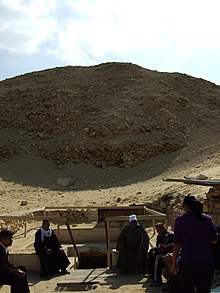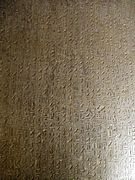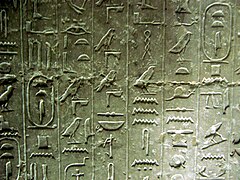Teti pyramid
| Teti pyramid | |||||||||||||||||||||||||||||||||||||||||||
|---|---|---|---|---|---|---|---|---|---|---|---|---|---|---|---|---|---|---|---|---|---|---|---|---|---|---|---|---|---|---|---|---|---|---|---|---|---|---|---|---|---|---|---|
|
|||||||||||||||||||||||||||||||||||||||||||
The Teti pyramid in Saqqara is the tomb of the Egyptian king Teti , the founder of the 6th dynasty and successor to Unas , the last ruler of the 5th dynasty .
Research history
The first documentation of the pyramid was carried out by John Shae Perring in 1839 . The publication took place in 1842 by himself and by Richard William Howard Vyse . Carl Richard Lepsius visited Saqqara during his Egypt expedition from 1842 to 1846 and documented the ruins there between December 1842 and May 1843. He added the Teti pyramid to his list of pyramids under the number XXX . Gaston Maspero was the first to penetrate the chamber system in 1882. The pyramid texts found there were copied by Emil Brugsch , Urbain Bouriant and Charles Wilbour .
Systematic excavations around the pyramid began in 1905 under the direction of James Edward Quibell . This initially lasted until 1908. Between 1920 and 1924, a large part of the mortuary temple was examined by Cecil Mallaby Firth . From the 1950s, further excavations took place under the direction of Sainte Fare Garnot , Philippe Lauer and Jean Leclant .
The pyramid
The superstructure
The construction corresponds to a prototype of the late Old Kingdom. It has a base length of 150 cubits (78.8 m) and with an incline of 53 ° 7 'the original height of the pyramid was about 100 cubits (52.5 meters). It is about the same size as the pyramid of Djedkare or the later built pyramids of Pepi I and Pepi II. The core of the Teti pyramid consists of five steps, which were built from locally mined limestone and filled with rubble. The outer cladding was made of fine limestone of unknown origin.
The north chapel
The entrance at ground level is in front of the north side of the pyramid in the paved courtyard and is enclosed by a small north chapel. This has a length of 7 cubits (approx. 3.675 m) and a width of 6 cubits (approx. 3.15 m). On its south wall was a stele made of basalt .
The chamber system
From the chapel, a corridor clad in rose granite at the upper end leads downwards with a gradient of 22 ° and a length of 17 m. It opens into a small passage chamber and then continues horizontally for about 25 m. Halfway there is a blocking device with three granite falling stones. The end of the horizontal corridor is also clad in rose granite. It opens into an antechamber, which is located directly below the top of the pyramid. It measures 3.75 m from east to west and 3.12 m from north to south. A short corridor leads east into the Serdab . This has three niches and is 6.75 m wide and 3.07 m long. On the west wall of the antechamber, another short corridor leads into the coffin chamber, which measures 3.45 m × 7.90 m. Three layers of large, sloping limestone beams form the ceiling of both the antechamber and the coffin chamber in the form of a gable roof construction. In the western part of the grave chamber is composed of greywacke -made sarcophagus , which, like the walls of the excavation and pre-chamber and the adjacent corridor with Pyramid Texts is decorated. The sarcophagus is quite well preserved, only the lid was badly damaged by grave robbers. To the southeast of the sarcophagus is a small pit in the floor, in which the canopic box originally stood. Parts of a human arm and shoulder blade, as well as a small tablet of alabaster labeled with the names of seven sacred oils found in the rubble that filled the burial chamber, may have come from the original burial .
The chamber system is largely a copy of that of the Unas pyramid . The layout and dimensions of the rooms are largely identical, only the corridors are a little longer due to the larger area of the Teti pyramid. The most noticeable difference is the ceiling construction, which in turn is based on the Djedkare pyramid , whereas the Unas pyramid has only a single, instead of a triple gable roof. Another difference is that the west wall of the burial chamber is not clad with alabaster, but only with limestone. In addition, the adoption of pyramid texts on the sarcophagus is an innovation.
The pyramid complex
Valley temple and way
The valley temple of the Teti pyramid has not yet been discovered. The pathway was largely destroyed by the temple terraces of the Serapeum . From the preserved confluence with the mortuary temple it can be seen that the valley temple and the access road were not in line with the mortuary temple and the pyramid, but were offset strongly to the south. This most likely happened to avoid the Lepsius XXIX pyramid , which has now been identified with some certainty as the tomb of King Menkauhor .
The mortuary temple
To the east of the pyramid was a large mortuary temple , of which only a few remains are left due to extensive stone robbery. To the south-east of the pyramid is a small cult pyramid , which, together with the main pyramid and the inner part of the mortuary temple , was surrounded by an enclosure wall.
The queen pyramids
To the northeast of the complex are the remains of two smaller pyramids, which are attributed to the royal wives Iput I and Chuit . In 2008 a third pyramid of queens was discovered, which may have been built for Teti's mother, Seschseschet . In the vicinity of the pyramid, an important and densely built necropolis developed over time . Among them are the mastabas of Mereruka , Kagemni , Gemniemhat and the tomb of Tjeteti .
Other buildings around the pyramid
Furthermore, the Anubieion and the Bubasteion from Greco-Roman times were to the east of the pyramid .
literature
- Mark Lehner : The first wonder of the world. The secrets of the Egyptian pyramids. Econ, Düsseldorf et al. 1997, ISBN 3-430-15963-6 , pp. 156-157.
- Bertha Porter , Rosalind LB Moss : Topographical Bibliography of Ancient Egyptian Hieroglyphic Texts, Reliefs and Paintings. Volume III. Memphis. Part 2. Saqqara to Dahshur. Griffith Institute, Oxford 1981, ISBN 0-900416-23-8 , pp. 393-397. ( PDF; 33.5 MB )
- Rainer Stadelmann : The Egyptian pyramids. From brick construction to the wonder of the world (= cultural history of the ancient world . Volume 30). 2nd, revised and expanded edition. Philipp von Zabern, Mainz 1991, ISBN 3-8053-1142-7 , pp. 188-193.
- Miroslav Verner : The pyramids (= rororo non-fiction book. Volume 60890). Rowohlt, Reinbek bei Hamburg 1999, ISBN 3-499-60890-1 , pp. 380–388.
Web links
- Teti pyramid ( Memento from December 10, 2007 in the Internet Archive ).
Individual evidence
- ↑ John Shae Perring, EJ Andrews: The Pyramids of Gizeh. From Actual Survey and Admeasurement. Volume 3, Fraser, London 1843, p. 9, plate 7 (online)
- ^ John Shae Perring, Richard William Howard Vyse: Operations carried on at the Pyramids of Gizeh in 1837: With an Account of a Voyage into Upper Egypt, and Appendix. Volume 3, Fraser, London 1842, p. 39 (online)
- ↑ Monuments from Egypt and Ethiopia. Text. First volume. Lower Egypt and Memphis. Edited by Eduard Naville and Ludwig Borchardt, edited by Kurt Sethe. Hinrichs, Leipzig 1897, pp. 188–189 (online)
- ^ Queen's Pyramid Discovered at Saqqara
- ↑ SCA press release: Queen's pyramid discovered in Saqqara. In: Sokar. No. 18, 2009, pp. 24-25, [1] .
Coordinates: 29 ° 52 ′ 31 ″ N , 31 ° 13 ′ 17.8 ″ E







